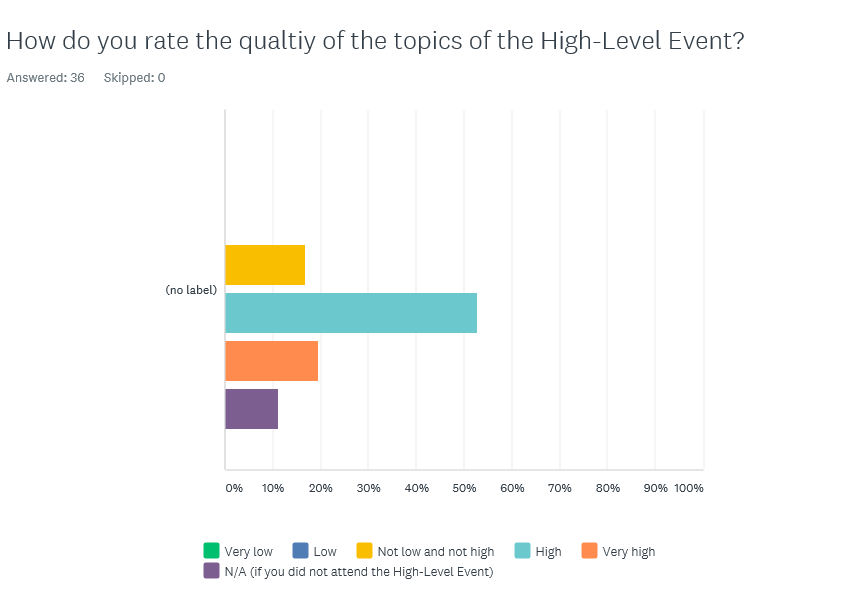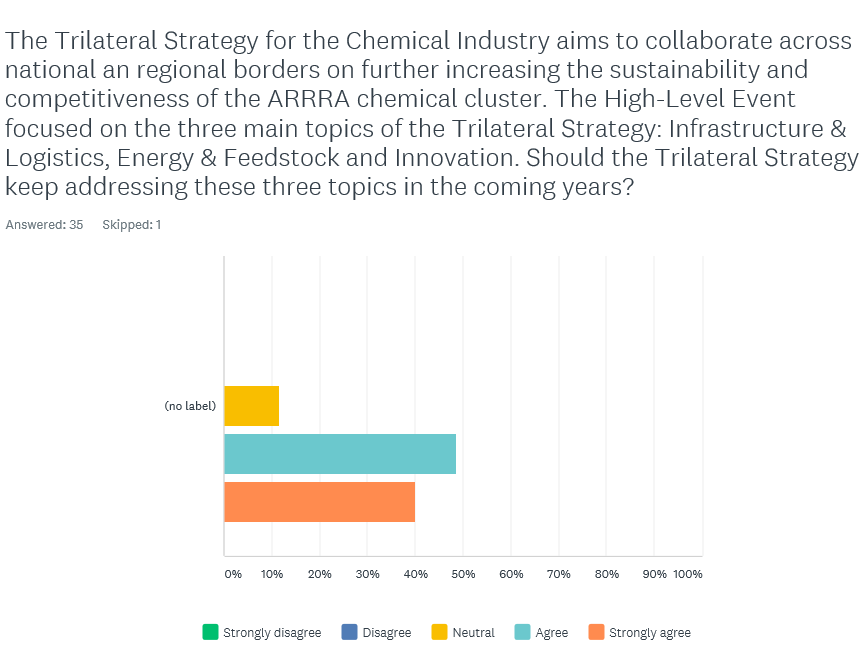Results of survey
High-Level-Event 2020
Feedback on the High-Level Event
Analysis: The answers to questions 1 and 2 below show that the quality of the High-Level Event and the topics it addressed was mostly rated high.
Q4 What could have been improved in the organisation of the High-Level Event? (open question)
19 responses received. The following are topics addressed by more than one respondent, in order of number of respondents addressing them in their answers:
1. More interaction (7 respondents)
Mentioned suggestions: Q&A with audience, answering all questions asked via chat after the event, networking after the official part of the event
2. Technical problems with Webex (4 respondents)
3. No improvements suggested, the event was fine as it was (for an online meeting) (3 respondents)
Suggestions for the Trilateral Strategy in the coming years
Analysis: The answers to question 5 show that the respondents consider the topics Infrastructure & Logistics, Energy & Feedstock and Innovation to remain relevant as pillars of the Trilateral Strategy.
Analysis: The answers to questions 6 and 7 (below) show that the supply of fossil-free energy and the improvement of infrastructure in the ARRRA cluster are high on the agenda of the respondents, for both becoming more sustainable and remaining competitive. Innovation is needed to become a sustainable cluster, and this requires both industrial and public investments at a substantial scale. Coherent long-term policy and creating a level-playing field by addressing regulatory differences within the trilateral region and between the trilateral region, the rest of the EU and the rest of the world are also raised as important by several respondents.
The answers to question 8 (below) show that a good number of respondents are happy with the current focus and course of the Trilateral Strategy and have no additional suggestions. Also, suggestions are given to involve other stakeholders outside the region and the chemical industry if that is necessary for success. There is a call to provide more information publicly about which topics are worked on, which could mean that the Trilateral website is not yet well known and/or can be promoted more actively.
Q6 What are the three most important challenges to becoming a sustainable ARRRA chemical cluster, in order of priority? (three open answers requested)
30 responses received. The following are topics addressed by more than one respondent, in order of number of respondents addressing them in their answers (between brackets the numbers of respondents who ranked the topic as most important / 2nd most important / 3rd most important):
2. Cross-border development of infrastructure (4/3/4)
3. Striking a balance between making the energy transition happen while remaining competitive, through innovation (4/0/0)
4. Different laws, national thinking and approaches in the countries and in EU, e.g. on funding, infrastructure, waste (2/3/3)
5. Companies’ commitment to make major investments to develop and implement new technologies (2/2/0)
6. Include scope 3 emission reduction in targets and accounting (2/0/0)
7. Developing a strategy for sustainable feedstock (1/2/2)
8. Public (& political) acceptance/support, for e.g. infrastructure (1/2/0)
9. Common goal setting between companies (1/1/0)
10. Cross-border funding from countries and EU (0/3/2)
11. Level playing-field with competition from outside EU (US, China) (0/2/2)
12. Awareness that the transition is inevitable (0/1/1)
Q7 What are the three most important challenges to remaining a competitive ARRRA chemical cluster, in order of priority? (three open answers requested)
27 responses received. The following are topics addressed by more than one respondent, in order of number of respondents addressing them in their answers (between brackets the numbers of respondents who ranked the topic as most important / 2nd most important / 3rd most important):
1. Sufficient and cost-competitive supply of fossil-free energy, including infrastructure for transport and technology for storage (of e.g. H2) (7/2/0)
2. Improved infrastructure (rail/waterways/pipelines/energy infrastructure) (4/3/3)
3. Companies working together (3/0/0)
4. Level playing-field on a global level (3/0/0)
5. Taking decisions fast, avoiding the cost of inaction (2/1/2)
6. Availability of sustainable feedstock (2/1/1)
7. Public acceptance and political back up (1/0/1)
8. Funding for R&D&I across trilateral inner borders (0/6/2)
9. Large-scale public funding for CAPEX of industrial implementation (0/2/2)
10. Coherent longer term policy (cost of CO2) (0/2/1)
11. Recruiting and retaining of talented staff for the transition (0/0/3)
12. Carbon circularity (0/0/2)
Q8 Please give us your suggestions for improving the Trilateral Strategy (open question)
15 responses received. The following topics were addressed by more than one respondent, in order of number of respondents addressing them in their answers:
1. All good/no changes required (4 respondents)
2. Enhance participation of companies and (regional) authorities, allow others to join if needed to be more successful (2 respondents)
3. Provide more information/meetings about what has been accomplished/is going on (2 respondents)





